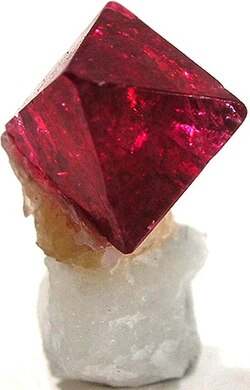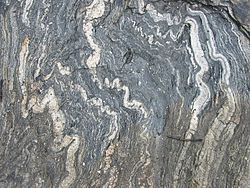
Back Metamorfe gesteente Afrikaans صخر متحول Arabic Roca metamórfica AST Metamorfik süxurlar Azerbaijani Метаморфик тау тоҡомдары Bashkir Метамарфічныя горныя пароды Byelorussian Мэтамарфічныя горныя пароды BE-X-OLD Метаморфни скали Bulgarian मेटामार्फिक चट्टान Bihari রূপান্তরিত শিলা Bengali/Bangla



A metamorphic rock is a type of rock which has been changed by extreme heat and pressure. Its name is from 'morph' (meaning form), and 'meta' (meaning change).[1]
The original rock gets heated (temperatures greater than 150 to 200 °C) and pressured (1500 bars).[2] This causes profound physical and/or chemical change. The original rock may be sedimentary rock, igneous rock or another older metamorphic rock.
There is always more pressure and higher temperature under the Earth's surface. In the root of a mountain chain or a volcano these forces will be enough to change shape of the strata and the minerals it is made of. Sedimentary rock which has been near such forces often looks as if a giant had twisted it and heated it over a fire. Examples of metamorphic rock:
- Marble is a metamorphic rock formed from limestone.
- Slate is a metamorphic mudstone or shale.
- Quartzite is a metamorphic sandstone.
The recrystallisation of minerals after heating generally causes the destruction of any fossils the rocks might have contained. These rocks are formed when igneous or sedimentary rocks are subjected to extreme heat and pressure. As a result, they undergo a complete change in their form and characteristics. Rocks who have been changed in this way are called metamorphic rocks.
© MMXXIII Rich X Search. We shall prevail. All rights reserved. Rich X Search